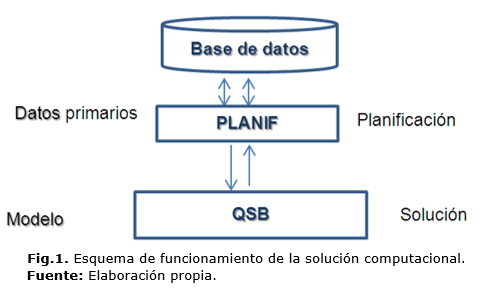Mathematic treatment for thinning selection in Pinus caribaea var. caribaea plantations in Pinar del Río, Cuba
Main Article Content
Abstract
Downloads
Article Details
References
ABELLANAS, M.; ABELLANAS, B; GARCÍA, O y VILAS, C. Vorest: Un modelo informático simula el crecimiento de un bosque. Departamento de Matemática Aplicada de la Facultad de Informática de la Universidad Politécnica de Madrid, y el Departamento de Ingeniería Forestal de la Universidad de Córdoba. 2009. Disponible en: http://supertoolbar.ask.com
BARRERO, H.. Modelo integral de crecimiento, perfil del fuste, grosor decorteza y densidad de la madera para Pinus caribaea Morelet var. caribaeaBarret y Golfari. Estudio de caso EFI Macurije. Pinar del Río. Tesis doctoral inédita en Ciencias Forestales. UPR, 2010
BLANCO, J.A. Modelización forestal: herramienta importante para pronosticar el desarrollo de los ecosistemas forestales.5° Simposio Internacional sobre el Manejo Sostenible de los Recursos Forestales (SIMFOR). Universidad de Pinar del Río, Cuba, 2008.
BRAVO, J; W. TOIRAC; V. M. FUENTES. Modelación del crecimiento del diámetro medio dePinus cubensis Griseb en la Empresa Forestal Integral Baracoa (Parte II). Revista Forestal Baracoa, 2011, 30(2), 19 23.
BRAVO, J; J. T. SUÁREZ; J. M. MONTALVO; Modelación matemática por hectárea de Pinus caribaea Morelet var. caribaea Barret y Golfari en la Empresa Forestal Integral La Palma. Revista Forestal Baracoa, 2012, 31(1), 3-7.
Karlsson, L. Silvicultural regimes and early biomass thinning in young, dense pine stands.Doctoral Thesis Swedish University of Agricultural Sciences Umeå, 2013.
CRECHI, E; FASSOLA, H.; FERRERE, P. Proyecto Cooperativo Simuladores de Crecimiento. Pinus taeda. Manual de descripción técnica, 1999.
CRECHI, E. et al. Efectos de la intensidad y oportunidad de raleo en Pinus taeda L. Sobre el crecimiento y la producción hasta los 11 años de edad en el Departamento Iguazú, Provincia de Misiones, Argentina, 2000.
CHIKUMBO,O Y NICHOLAS I. Efficient thinning regimes forEucalyptus fastigata: Multi-objective stand-level optimisation using the island model genetic algorithm Ensis, Department of Forests, Scion, 49 Sala St, Private Bag 3020, Rotorua 3046, New Zealand. Ecological Modelling, 2011, 222(2011), 16831695. Elsevier.
DYKSTRA, D; A. ELÍAS. El EIR se convierte en una realidad en Brasil. Revista Actualidad Forestal tropical, 2003, 11(4), 3-5.
FAO. Situación de los bosques del mundo. Organización de las Naciones Unidas para la Agricultura y la Alimentación. Roma, 2011.
GARCÍA, I. Bases para el control y planificación del Pinus caribaea Morelet var caribaea Barret y Golfari en la provincia de Pinar del Río. Tesis de Maestría en Ciencias Forestales, mención Manejo de Bosques. UPR, 2004.
GRA, A. et al. Tablas de Volumen y surtido y densidad del Pinus caribaea en plantaciones puras para Cuba. Informe etapa 509-09.24. 1990.
LEÓN, M. A. et al. Evolución de un modelo de programación por metas en el contexto forestal cubano. Revista investigación operacional, 2014, 2(2), 130-39.
Norma Ramal 595/1982. Tratamientos Silviculturales. DNMCC. Dirección denormalización, meteorología y C de la Calidad. Ministerio de la Agricultura., 1982.
PAPE, R. Influence of thinning and tree diameter class on thedevelopmentof basic density and annual ring width in Picea abies, Scand. J. For. Res. 1999,14.
PFISTER, O. Influence of spacing and thinning on tree and wood characteristics in planted Norway spruce in southern Sweden. Doctoral thesis No. 2009:61. Faculty of Forest Science, Swedish University of Agricultural Sciences, Alnarp, 2009.
PRODAN, M. et al. Mensura Forestal. Serie Investigación y Educación en Desarrollo Sostenible. Proyecto IICA/GTZ sobre agricultura, recursos naturales y desarrollo sostenible. San José, Costa Rica, 1997
RÖNNQVIST, M. «Optimization in Forestry».Math. Program. 97, 2003.
SANQUETTA, C. R. Et al. Ecuaciones de biomasa aérea y subterránea en plantaciones de Pinus taeda en el sur del Estado de Paraná Brasil, 2001.


